Renewing my U.S. visa
Posted by Wesley on
The first time I traveled to United States since I left North America in the mid 1990's was back in 2006. South Korea was not on the Visa Waiver Program (VWP) at the time. So I, like most of the Korean nationals, first needed to come to the U.S. Embassy in Seoul to submit an application for a B1/B2 non-immigrant (visitor) visa and go through an interview. I wrote about the entire experience in detail, including the long lines.
The resulting visa has served me well for the past decade, even after South Korea was admitted into the VWP on November 17, 2008. This was because valid visa holders don't need to get the ESTA (Electronic System for Travel Authorization) clearance. But it ultimately expired and because I have an upcoming business trip to the States, it was time to renew it.
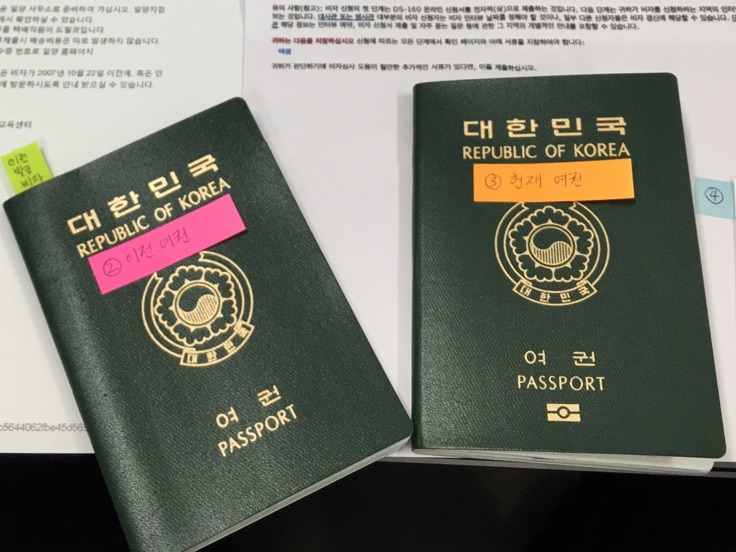
There have been considerable changes in preparation. In 2006, the "electronic" aspect was that the application forms (DS-156 & 157) were downloadable and that the interview could be scheduled online. As I write this, the form was changed to DS-160 and the entirety of it could be entered online (including the photo), needing only a simple "confirmation page" to bring in instead of the entire form. Also, payment process became simpler. There are no separate interview fee and processing fee anymore - it's all included in the processing fee now. And depositing the fee online to a uniquely generated account number (doubling as a "proof of payment") became possible in addition to the traditional option of having to visit a bank branch. However, the price has risen from $112 total to $160 for the B1/B2 visa.
Once the payment was made and the form was filled, the next step was to schedule an appointment for the interview. But since I was renewing the visa, I was apparently eligible for the Interview Waiver Program (IWP). Thanks to this, I was allowed to use the drop-box service at the interview reservation page after answering several questions to confirm my IWP eligibility.
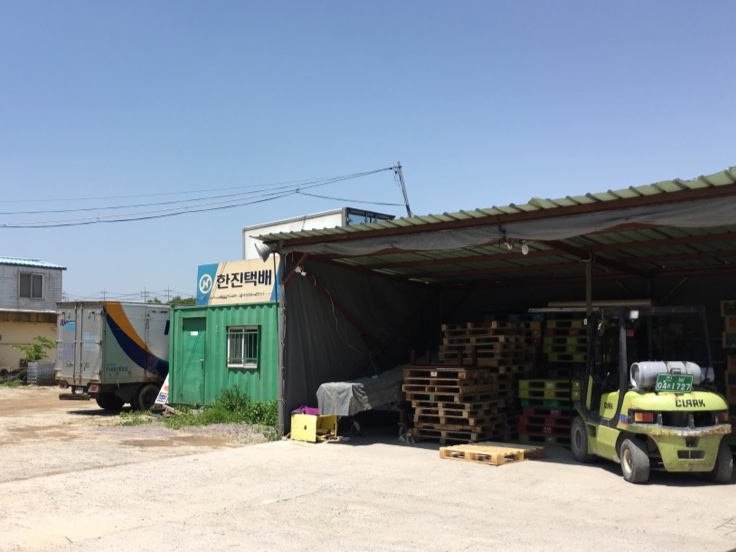
Drop-box service basically means I can "drop off" the necessary documents (passport, confirmation page, etc.) at a branch office of a contracted courier (Ilyang Logis, in this case) and it would be shipped to the embassy for processing at no extra cost. There was one such office at the small town I live in (Naju), so I decided to pay a visit. But as you can see here, it was expectedly small and the staff had no idea that such service existed. Apparently, I must have been the first person to try this at the place. After contacting the head office and getting the instructions, the staff collected the documents I brought and promised me that they would be sent soon. They had to be put into a special packaging that had to come from the head office, so in reality it took about three business days instead of going out the same day.
The resulting visa has served me well for the past decade, even after South Korea was admitted into the VWP on November 17, 2008. This was because valid visa holders don't need to get the ESTA (Electronic System for Travel Authorization) clearance. But it ultimately expired and because I have an upcoming business trip to the States, it was time to renew it.

Old passport on the left, new "biometric" passport on the right
There have been considerable changes in preparation. In 2006, the "electronic" aspect was that the application forms (DS-156 & 157) were downloadable and that the interview could be scheduled online. As I write this, the form was changed to DS-160 and the entirety of it could be entered online (including the photo), needing only a simple "confirmation page" to bring in instead of the entire form. Also, payment process became simpler. There are no separate interview fee and processing fee anymore - it's all included in the processing fee now. And depositing the fee online to a uniquely generated account number (doubling as a "proof of payment") became possible in addition to the traditional option of having to visit a bank branch. However, the price has risen from $112 total to $160 for the B1/B2 visa.
Once the payment was made and the form was filled, the next step was to schedule an appointment for the interview. But since I was renewing the visa, I was apparently eligible for the Interview Waiver Program (IWP). Thanks to this, I was allowed to use the drop-box service at the interview reservation page after answering several questions to confirm my IWP eligibility.

Naju branch of Ilyang Logis and Hanjin Express
Drop-box service basically means I can "drop off" the necessary documents (passport, confirmation page, etc.) at a branch office of a contracted courier (Ilyang Logis, in this case) and it would be shipped to the embassy for processing at no extra cost. There was one such office at the small town I live in (Naju), so I decided to pay a visit. But as you can see here, it was expectedly small and the staff had no idea that such service existed. Apparently, I must have been the first person to try this at the place. After contacting the head office and getting the instructions, the staff collected the documents I brought and promised me that they would be sent soon. They had to be put into a special packaging that had to come from the head office, so in reality it took about three business days instead of going out the same day.
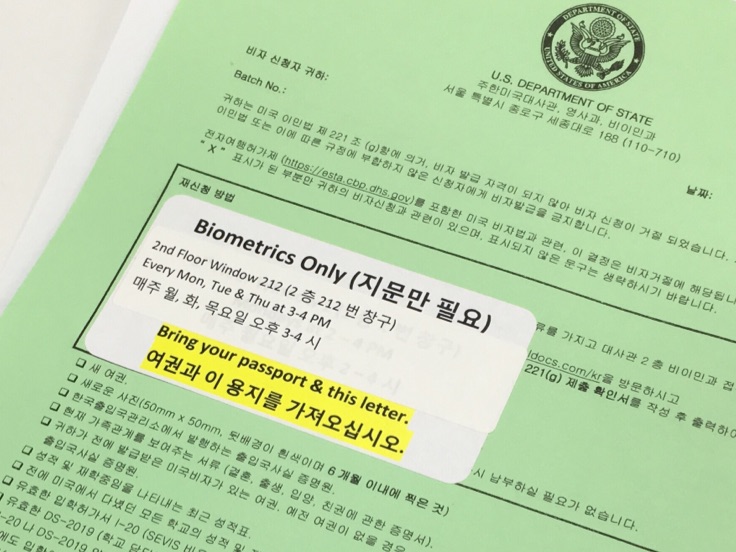
"Your visa application has been rejected - to reapply, we need your fingerprints"
Two days after the documents arrived at the embassy, they were returned to me. I was expecting the visa, but instead this green rejection letter was inside. Fortunately, it was far from an outright rejection - the embassy just wanted me to come in to register my fingerprints to complete the process. I thought this was strange because I had all my fingerprints scanned when I entered the States back in 2012. Wouldn't that mean the fingerprints are already in the database? Nevertheless, I decided to make a quick trip to the embassy.
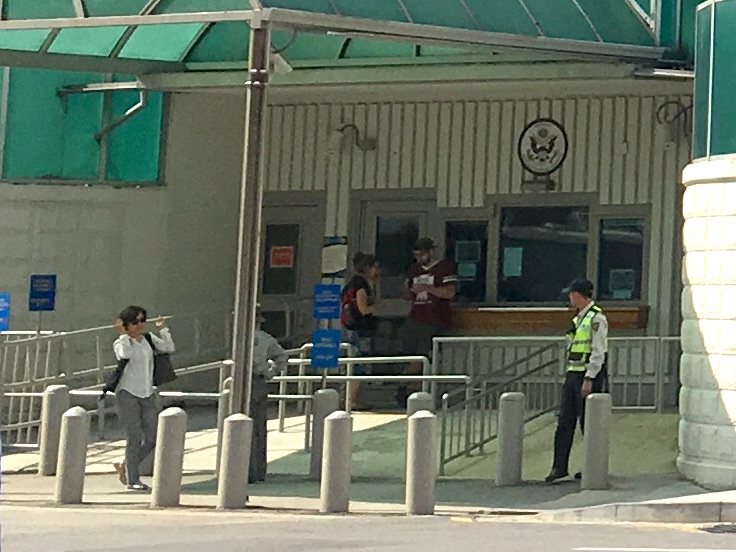
Entrance for visa applicants at the U.S. Embassy in Seoul
The entrance at the embassy has hardly changed in the past 10 years. The only thing different was the lack of the people lining up. The security procedures were the same, too - no phones or electronic devices past the security point. I walked up to the second floor and got my fingerprints scanned almost immediately. It seems that having them scanned at the U.S. point of entry in the past, ten fingers or not, was irrelevant and you have to have done the scanning at the embassy at least once. I suppose I won't need to make this visit 10 years later, then.
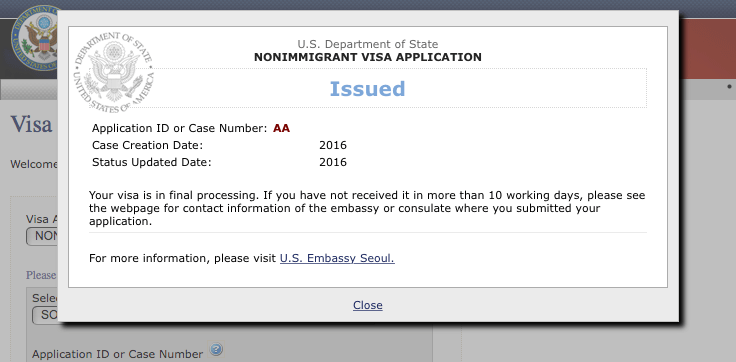
My U.S. visa renewal has been approved
The next day, I checked the status of my visa application online and to my relief it had changed to "Issued." The passport with the visa on it would be shipped back to me in a few days, making it one step closer in the preparation for my upcoming business trip.